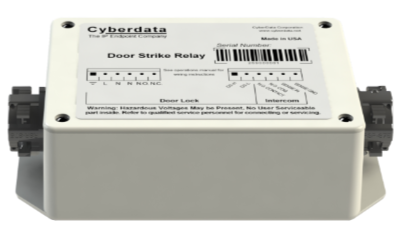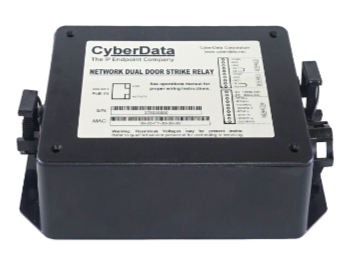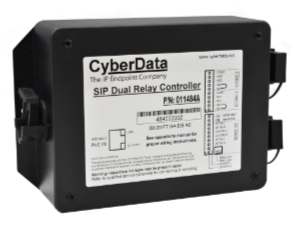Devices and Accessories to Better Install Access Control Solutions
A better understanding of how Access Control Systems work
First, we need to understand what a relay is. A relay is essentially a switch controlled electronically that it's very often used in IoT and in Telecom, to just go and enable different things, without actually having to physically go over there and click or toggle a switch or push a button.
There are two different variations that you can run into, when you're dealing with relays: normally open commonly referred to as "NO" or normally closed "NC", and these are basically just two different styles of a circuit where some devices need to be consistently energized with a normally closed circuit and on a normally open when the circuit is open you toggle the relay and it temporarily closes the circuit, so that way the electricity can flow. The way you can pick the right unit is going to depend on the actual application of what you're trying to do.
The vast majority of the products for security and access control come with a relay on board and it is probably the industry standard to have a normally open style relay, when you're going to use it remotely to unlock a door.
Applications when you're going to actually use different relays over traditional access control solutions
When you're dealing with traditional access control to access a door, you can use a strike which is going to have a normally open style relay or you could use a magnetic lock that is going to have a normally closed dial relay, and these are just two different ways to actually control locking a door.
The more common option is using a door strike where the system is not electrified on its locked position, and then you engage it by electrifying the system completing the circuit, and then the system engages and the door is unlocked. That's the most traditional option because it doesn't require any kind of energy to actually stay in the physical locked state, whereas with a magnetic lock will require a normally closed circuit because they're electromagnets they require electricity to flow through them, to keep the big magnet stuck to and keep the door physically shut.
In some applications magnetic locks can be substantially more secure because of the magnetic lock that generates a force that allows it to hold the door closed, but if you lose power and your electronic magnet doesn't have electricity, you need something else to keep that door closed. A lot of times magnetic locks are also paired with traditional physical security locks and in the event of a power outage you are able to keep that system locked.
Useful products that could be used to assist to achieve a better installation in an easier way
When connecting a SIP enabled door opener to an electronic door lock, the high current side of the door strike requires a separately-wired relay and protection diode.
CyberData's Door Strike Relay Modules and Relay Controller eliminate the need for the customer to source a separate relay, making wiring and using an electronic door strike easier.
Applications include electronic door strikes and other high current machine control as well as fire, security or alarm panels, air quality or temperature sensors, or devices that you would control from a distance.
 CyberData Door Strike Relays: Powering Your Access Control Systems
CyberData Door Strike Relays: Powering Your Access Control Systems
The Intermediate Door Strike Relay, from CyberData is a door strike relay module and it works both normally open and normally closed, being good for dealing with higher power circuits whether it's higher voltage or higher amperage. If you want to run something through your access control system, but it's above that one amp at 30 volt DC that the door opener onboard relay supports, you will need something like this, or if you're dealing with a normally closed style circuit like the maglock mentioned before, you need this accessory too.
One potential downside to this is that it should be physically connected to the door opener where it closes its relay, completing the circuit, which then tells the connected door strike intermediate relay module that it needs to either close or open its normal circuits. That way it could interfere with the primary relay that is working, and that creates a potential security flaw, in many environments like if you're dealing with two doors, for example.

Network vs. Intermediate Door Strike Relays: Security Considerations
The Network Dual Door Strike Relay is a more advanced option, it has both normally open and normally closed style relays and it's also rated for a higher power circuit and it can control one door but it can be used for two doors (no side-by-side style) in a man trap style where you're coming through the first door and then you're let through the second door. One security benefit to the network dual door strike relay over the onboard relay is that there is no physical connection between the network dual door strike and the door opener that is controlling it, so that way all communication and actual opening of the door is handled over the actual network, without any the wires that would be connected or disconnected to open the door or on then secure side of the door, and this means that it's that much harder for somebody to gain access to the facility. Furthermore the device provides an encrypted communication method for secure access.
 Dual Relay Controller: More Than Just Door Control
Dual Relay Controller: More Than Just Door Control
The Dual Relay Controller which is a little bit different of the two described above, uses a similar hardware platform to the Network Dual Door Strike Relay but it has more capability. It is a PoE-powered IP device which controls two high amperage relays to manage the unlocking and locking of doors, or activation and deactivation of a device. It is a full based relay controller meaning that can register with your phone system providing the capability for two different relay connections (both normally open and normally closed dial relays), so you can connect to either style device and this can be as simple as just connecting it to a door for regular door control, like for example an interior door inside a building that you want to keep locked outside of business hours, but you want to keep it open during certain times or you want the capability to control over the phone. The system can be used to manage hardware devices with control of its relays also paired with the device management aspect of it. The SIP Dual Relay Controller has two on-board sensor inputs which are basically the inverse of a relay where the relay is either for connecting or unconnecting two pins.
You can get these CyberData devices from ABP Technology for your Access Control Solutions.







